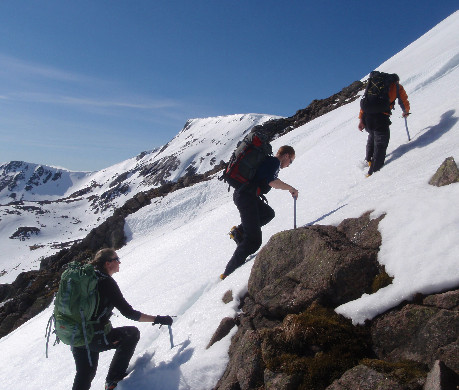Winter mountaineering in Scotland offers some of the best mountain days anywhere, with rugged, challenging mountains, the sharp bite of clean, cold mountain air, and crystal clear views of incredible snowy vistas under clear blue skies.
On the flip side, winter mountaineering in Scotland also offers howling winds you canít stand up in, choking spindrift and zero visibility in white-outs and thick, claggy cloud. Weather patterns are unpredictable and change rapidly from warm and wet to cold, storm force blizzards.
Itís all worth it for the good days, but anyone heading for the
Scottish mountains in winter must be prepared for the worst Ė and thatís
why the experts say that any ascent of Scotlandís mountains in winter
should be regarded as mountaineering rather than hill walking.

Photo by Heather Morning
In winter conditions Ė and those are determined by the presence of snow and ice rather than calendar date Ė safe ascent and descent are likely to be dependent on the use of technical equipment such as ice axes, crampons and even skis, and associated mountaineering skills.
There is also a distinct lack of way-marked paths in the higher mountain areas, making easy access impossible. The wild land areas, although shrinking, are still large enough to mean considerable distance may have to be travelled across rough terrain in order to climb many cliffs, ridges and mountain tops.
This lack of paths and tracks means mountaineers need to be skilled in navigation and be self-sufficient.

Safety should always be a priority, but it really does become a prime consideration in winter conditions.
You should be thoroughly familiar with all the advice and techniques contained in the Safety & Skills section of our website.
You can also learn from the mistakes of others, on our Near misses page, where many of the mishaps occurred during winter conditions.